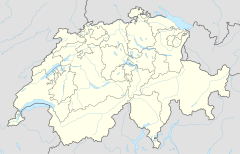Kloster Allerheiligen, Schaffhausen
| Kloster Allerheiligen | |
|---|---|

Entrance of Münster Schaffhausen
|
|
| General information | |
| Architectural style | Former Benedictine abbey, Museum, |
| Classification | Historic monument |
| Town or city | Schaffhausen |
| Country | Switzerland |
| Coordinates | 47°41′42″N 8°38′12″E / 47.694897°N 8.63675°E |
| Construction started | 1049 |
| Completed | 1064 |
Kloster Allerheiligen (All Saints abbey) is a former Benedictine monastery in the Swiss municipality of Schaffhausen in the Canton of Schaffhausen. The church Münster Allerheiligen is the oldest building in Schaffhausen, and houses also the Museum zu Allerheiligen.
Today the convent houses the Museum zu Allerheiligen, an art museum and a natural history museum, the monastery garden, and the buildings of the former convent, including the library. The former monastery's building complex is located at the center of the historic old city of the municipality of Schaffhausen in the Canton of Schaffhausen, includes the oldest buildings that still exist in Schaffhausen.
The development of the city of Schaffhausen is closely linked to the Nellenburg noble family who became extinct around 1100 AD. Various archaeological finds and the building of the present church of St. Johann (John) date back to around 1000 AD. The Earls (German: Grafen) von Nellenburg recognized the importance of the geographical area as a transshipment of goods on the Rhine river, and the order to bypass the Rheinfall waterfalls, controlled by the Wörth Castle. The monastery was founded by Eberhard von Nellenburg in 1049, on 22 November it was consecrated by Pope Leo IX, and in 1064 the construction works were completed. The church was dedicated to the Saviour, the Holy Cross, the Virgin Mary and All the Saints. In 1067 count Eberhard strengthened his rule in Schaffhausen, and received by Pope Alexander II comprehensive protection and sovereign rights for the monastery. Allerheiligen became, instead of the Reichenau Abbey, the new grave lay by the founding family, and various renovations and additions. Eberhard became after 1075 a Benedictine monk in the abbey, and died there in 1078 or 1079. He was buried in the outdoor crypt that was built for the family.
...
Wikipedia

